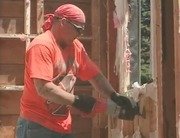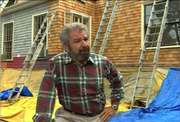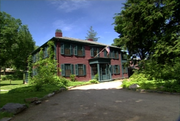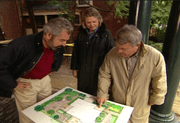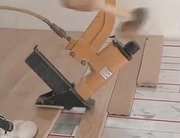There are many great features to a late nineteenth-century house.
One of my favorites are the original sash, with glimmer glass.
Rolled glass, which in the process of manufacturing, creates these vertical lines.
And the rollers do that but what you have is, kind of the effect of this glimmer as you move across and look at the view across the street.
It's really neat.
One of the disadvantages of the old sash are the sash weights, these pig iron things that travel up and down on either side of the window and allow the sash to operate.
They also create a huge energy loss because you can't insulate in there unless you remove them.
And if you added up all the volume throughout the house, it's almost the equivalent of leaving the front door open all winter long.
So we're changing that.
Let's hook up now with Greg Rockland, our architect, and Danny Ruffini, who's doing all this improvement.
He fellows, Rick, how you doing?
Hi, Bob.
How are you?
Now one of the key things that you had to do here, was the actual size of the window right?
Well, we're probably the fourth or fifth group to work on these windows because they're 100 years old and in all that time with wear and refitting and putting changing sash cords, the windows were a quarter inch smaller than the jams at this point.
So they really wobbled around.
They were wobbling around.
You couldn't make them tight.
And now you got them nice and tight.
That' right.
What did you have to do?
Well, we relined all the jambs with cedar.
Yeah.
How thick is that cedar?
That's an eighth of an inch.
Okay.
And then we put in new parting beads, new stops, all, so you've basically got, like, a new jamb.
And of course these windows have interlocking weather stripping which you can see right along here.
So that is being preserved as well, right?
Yes, and we're just re-adjusting it.
But the key thing is the spring loading balances that your installing, why don't we figure out exactly how these go in.
Well this is a spring loaded balance, and it's a spiral, and you could apply tension to it to balance the weight of the window.
And this bracket here has to be in routed into the bottom of the sash, and that's what Danny is doing now.
OK, you've got your eye protection on.
And its just a short three inches that you have to rout out.
That's right.
OK.
So we take the jig off.
And this you just really made up for this job.
OK.
Now it looks fairly simple but is it that simple to?
Well, it really isn't.
You have to work out a process.
Every window and every household is different and Danny and I Have done up sort of a test window where we understood all the problems, got the bugs worked out and
then Danny has built a set of jigs and templates and pre-cut all of wood, so now we've got 25 sets of windows to do and we can go through in a very efficient way and do
them.
OK, now do we take it to the opening?
A little bit tricky maneuvering here But Greg, do you think this is the kind of job an average do-it-yourself-er can tackle?
No, I don't think so.
You need a professional and a lot of experience doing this kind of window.
This is a lot of operations and if you make a mistake you've ruined your window.
Alright now this is the easy part right, Greg?
Right.
We just need to get this tube up here so Danny can screw it to the top of the jam.
but once they're both fastened up to the top, then all the adjustments have to be made.
Yes, that's sort of tricky because you've got to crank up this spiral balance so the spring tension equals the weight of the window and that takes some experience.
Sounds like a good time for us to break for some messages.
Stick around.
And this of course is the last critical step to get the right amount of tension, but we're running out of time.
Come home again next week when we'll be installing a lavatory in the downstairs powder room and taking you to Kohler, Wisconsin, to see how there made.
Also we expect to have our master bedroom closets fitted out.
Till then I'm Bob Vila.
It's good to have you home again.

